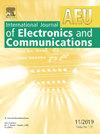在微波滤波器中插入波纹以减轻多因子效应的研究
IF 3.2
3区 计算机科学
Q2 ENGINEERING, ELECTRICAL & ELECTRONIC
Aeu-International Journal of Electronics and Communications
Pub Date : 2025-09-16
DOI:10.1016/j.aeue.2025.156036
引用次数: 0
摘要
多因子效应是一种电子雪崩型放电,对工作在高真空条件下的射频和微波大功率器件构成了重大挑战,影响了其信号完整性和器件性能。在本文中,我们建议在几个微波元件,特别是滤波器的内部金属壁上应用波纹表面轮廓,以减轻这种不良影响。通过数值模拟,我们证明了在组件的关键区域上引入波纹表面显着增加了多因素功率阈值。波纹剖面有效地破坏了导致电子雪崩形成的条件,从而提高了击穿阈值水平。我们探讨了波形轮廓的几何参数的影响,以及它应该放置在微波组件中的关键区域,为优化设计考虑提供见解,以减轻这种现象。我们的研究结果不仅有助于更广泛地理解射频和微波大功率元件中的多因子缓解技术,而且还为带通滤波器的应用提供了有价值的指导,在引入波纹表面轮廓后,大大提高了其多因子功率阈值,同时保持了原始设计组件的电性能。此外,所提出的解决方案通过避免使用材料涂层、微孔表面以及非标准波导,优于其他最先进的多因子减少技术,从而证实了其在高功率要求应用(如卫星通信系统)中与滤波元件一起使用的良好前景。本文章由计算机程序翻译,如有差异,请以英文原文为准。
Study of the insertion of corrugations in microwave filters for mitigation of the multipactor effect
The multipactor effect is an electron avalanche type discharge, that poses a significant challenge in radiofrequency and microwave high-power devices operating under high-vacuum conditions, affecting their signal integrity and device performance. In this paper, we propose to apply a corrugated surface profile over the inner metallic walls in several microwave components, especially filters, to mitigate this undesired effect. Through numerical simulations, we demonstrate that the introduction of a corrugated surface over critical areas of the component significantly increases the multipactor power threshold. The corrugated profile effectively disrupts the conditions leading to the electron avalanche formation, thereby increasing the breakdown threshold level. We explore the influence of both the geometric parameters of the corrugated profile, and the critical region where it should be placed in the microwave component, providing insights into the optimal design considerations to alleviate this phenomenon. Our findings not only contribute to a broader understanding of the multipactor mitigation techniques in radiofrequency and microwave high-power components, but also offer valuable guidance for their application with a band-pass filter example, resulting in a substantial improvement of its multipactor power threshold after introducing the corrugated surface profile, while maintaining the electric performance of the originally designed component. Moreover, the proposed solution outstands other state-of-the-art multipactor reduction techniques, by avoiding the use of material coatings, micro-porous surfaces as well as non-standard waveguides, thus confirming very good prospects for its use with filtering components in high power demanding applications, such as satellite communication systems.
求助全文
通过发布文献求助,成功后即可免费获取论文全文。
去求助
来源期刊
CiteScore
6.90
自引率
18.80%
发文量
292
审稿时长
4.9 months
期刊介绍:
AEÜ is an international scientific journal which publishes both original works and invited tutorials. The journal''s scope covers all aspects of theory and design of circuits, systems and devices for electronics, signal processing, and communication, including:
signal and system theory, digital signal processing
network theory and circuit design
information theory, communication theory and techniques, modulation, source and channel coding
switching theory and techniques, communication protocols
optical communications
microwave theory and techniques, radar, sonar
antennas, wave propagation
AEÜ publishes full papers and letters with very short turn around time but a high standard review process. Review cycles are typically finished within twelve weeks by application of modern electronic communication facilities.

 求助内容:
求助内容: 应助结果提醒方式:
应助结果提醒方式:


